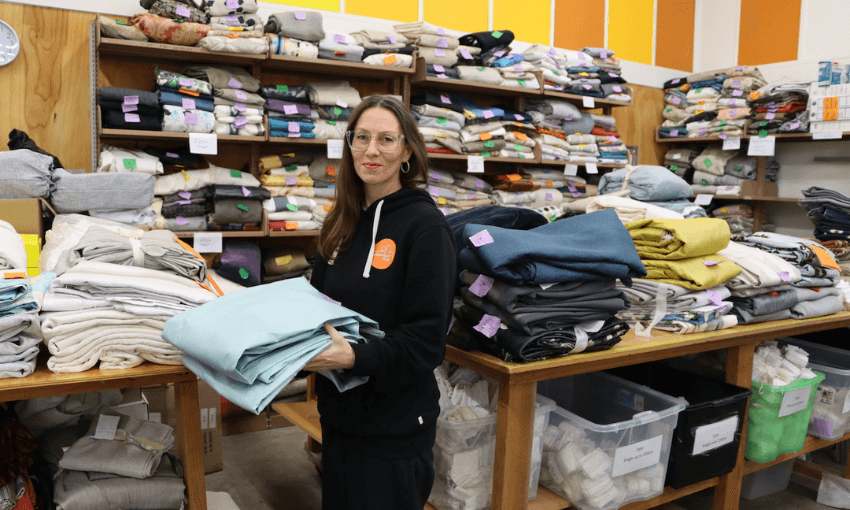At this strip club the dancers kept all their tips, there were no unfair overheads or fines and definitely no exploitative management.
The lights are dim, the bar glows, and everywhere there are beautiful dancers in lingerie. They’re unnaturally tall in their eight-inch heels, glamorous with their criss-cross ribboned legs, perfect make-up and hair. I, in my ordinary clothing, feel short and human next to them. That’s part of the fantasy though – they’re professionals, they’re performing, and I’m there to spectate.
It’s the Fired Up Stilettos (FUS) strip club takeover event and this is my Saturday night.
FUS is a collective movement of strippers fighting for labour rights and legal protection. It was formed in 2023 when 19 strippers were fired via Facebook post from Calendar Girls for attempting to collectively bargain for fair pay and contractual rights. Strippers and sex workers have long worked under subpar employment conditions – despite strippers generally only working for one club, they are classified as independent contractors and therefore don’t have employee rights and protections.
Strip clubs usually take huge cuts from their dancers’ tips and impose unfair and illegal fines on them. It’s also well known that sex workers face societal stigma and discrimination. Some sex workers struggle to find alternative employment if people know that they’ve done sex work. Agencies and forums have often failed to protect sex workers, even when sex workers have asked for help. As a result, sex workers have formed their own groups in order to help themselves.
FUS received media attention in 2024 when it called on parliament to grant sex workers the same labour rights as other independent contractors. In 2025, they continue to support collectivist action within workplace, creating and sharing educational resources so sex workers can know their rights, and campaigning for legislative change. Their takeover events dually serve as fundraisers to keep the movement running and demonstrations of what strip clubs run by strippers could look like. FUS strip clubs could be the industry standard – dancers keep all their tips, there are no unfair overheads or fines, and there’s definitely no exploitative management.
When I arrive at the secret location (only revealed on Saturday morning) I feel like I’ve stepped back in time. There are men with suspenders and grey felt caps, women in flapper dresses with feathers in their hair. A performer in a beaded cape sings in a smooth alto while playing cello. The bar serves Negronis, French 75 cocktails and sparkling wine. I order my first drink and move into the main space, where a pole has been set up in one corner, and dancer after dancer performs to songs of their choice. After they dance, they walk around the floor.
“Are you tipping tonight?” a dancer asks me.
I tuck $5 of strip club money into the waistband of her thong, determined to be a good strip club patron.
There’s something hypnotising about pole dancing. It’s one of the reasons I watch dancers on Instagram reels, admiring the grace of making something difficult look effortless.
I started pole dancing in February, and it’s made me appreciate good pole dancers so much more. Pole dancing is hard. I often leave classes with new bruises on my feet or calves. There’s a unique kind of pain that comes from trying to hold up your whole body weight by grasping a metal pole with your inner thighs. Sometimes, when learning a new move, I feel as cumbersome as a spinning chicken on a stick.
These dancers are polished. They demonstrate clear control over their bodies. It’s the way they climb the pole and shift from position to position, the dramatic thwack of their heels against the floor. I watch, entranced, while their bodies contort and extend, stretch and spin. They rotate slowly then fast, limbs arranged in graceful formations. The performances feel like a celebration, with both performers and patrons cheering each time someone does something impressive.
I run into several people I know. Zouk dance friends. A guy I did English literature at university with. There are maybe 30-50 people at the event across the night, with a slightly different demographic to that of a commercial strip club. There are probably more women among the patrons. The crowd is also younger, as lots of dancers, friends and partners have come along to support.
The real difference though is that everyone is there because they support sex worker rights, and this inherently means that they respect sex workers. Almost every stripper has a story of sexual harassment or abuse. The FUS takeover event is partially so fun because dancers feel safe to do their jobs.
“Does this feel different to a normal strip club?” I ask one patron, who tells me he drove from Palmerston North to be here.
“Definitely,” he says. “There’s no seedy atmosphere.”
In the dressing room, office tables have been joined together and are covered in a chaotic mess of bags, takeaway containers, make-up and clothes. Dancers fix their make up, relax on the couch, take breaks from working. I ask if I can take some photos, and a few of the dancers say yes. I get one great shot of them, backs to me on the couch. I airdrop the photos and by the end of the night, it’s already been posted on three different accounts. You have to admire the hustle.
After all, it’s not just the pole dancing they have to do. Everything they do out on the floor is a performance, from the walking around and tip collecting to the conversations and private dance. It’s work, and some of the dancers do this physically and emotionally difficult work for several nights a week. A lot of the FUS dancers now work independently, unwilling to once again be subjected to the working conditions of strip clubs. Some of the dancers have OnlyFans. Some of them have “ordinary” jobs in completely different industries. It doesn’t matter. Sex workers and strippers deserve employment protection just like everyone else. As long as there is a market for sex, there will be people who do sex work: those people should be able to work safely.
In a lot of ways, the evening feels just like being at a particularly elaborate party. The night passes quickly in the sparkly blur of conversations, glasses of French 75, the spinning pole. At one stage, I slip outside for a smoke break with three of the dancers and the MC. We shelter from the wind in front of a garage. As we move to leave, the garage door cracks open with a violent screech and we all jump.
I leave around midnight, when the event ends. I have a heavy head, sore feet from dancing, and several promises to keep in touch.
As I drift off to sleep, I keep seeing the dancers on the pole. In my head they’re still going round and round.





